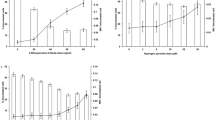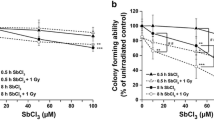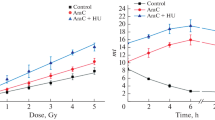Abstract
A number of metals have been shown to be involved in the etiology of animal and human neoplasms. The molecular mechanisms have not yet been determined, but the observed plethora of genetic effects observed following treatment of mammalian cells with metals clearly indicates the possibility that metals can exert their effects at least partially at the level of DNA metabolism. Several studies have suggested that metal treatment may inhibit normal DNA repair processes in procaryotic and eucaryotic cells but a systematic study of this question has not previously been conducted. The present study surveyed the ability of 15 metal salts to interfere with repair of X-ray or UV-induced DNA damage in HeLa cells. Hg++, As+++, Cu++, Ni++, Co++, and Cd++ were shown to inhibit the excision of pyrimidine dimers from DNA and to do so in a dose-dependent fashion. Inhibition of repair by only Ni++ and Co++ resulted in the accumulation of long-lived DNA strand breaks suggestive of a block in the gap-filling stage of repair. Ability to inhibit repair was not correlated with cytotoxicity. X-ray repair was sensitive to Hg++, Ni++, As+++, Ga++, Zn++, and Mo(VI). All inhibitory metals inhibited closure of single strand DNA breaks. Ga++ appeared, in addition, to inhibit a later step involving chromatin reconstitution. These findings support the notion that interference of DNA repair processes may be a consequence of exposure of mammalian cells to certain metals. This may be a factor in the etiology of metal-associated carcinogenesis.
Similar content being viewed by others
References
T. Rossman,Mut. Res. 30, 157 (1975).
H. Mochizuki and T. Kada,Mut. Res. 95, 145 (1982).
T. Okui and Y. Fujiwara,Mut. Res. 172, 69 (1986).
N. T. Christie, O. Cantoni, M. Sugiyama, F. Cattabeni, and M. Costa,Mol. Pharmacol. 29, 173 (1986).
S. Nocentini,Nucleic Acids Res. 15, 4211 (1987).
W. L. Carrier, R. D. Snyder, and J. D. Regan,The Science of Photomedicine, J. D. Regan and J. A. Parrish, eds., Plenum, NY, 1982, pp. 91–112.
R. D. Snyder,DNA Repair and Its Inhibition, A. R. S. Collins, S. Downes, and B. Johnson, eds., IRL Press, Oxford, 1984, pp. 13–33.
J. D. Regan and R. B. Setlow,Canc. Res. 34, 3318 (1974).
A. A. Francis, R. D. Snyder, W. C. Dunn, and J. D. Regan,Mut. Res. 83, 159 (1981).
A. Collins, C. S. Downes, and R. T. Johnson, eds.,DNA Repair and Its Inhibition, IRL Press, Oxford (1984).
Author information
Authors and Affiliations
Rights and permissions
About this article
Cite this article
Snyder, R.D., Davis, G.F. & Lachmann, P.J. Inhibition by metals of X-ray and ultraviolet-induced DNA repair in human cells. Biol Trace Elem Res 21, 389–398 (1989). https://doi.org/10.1007/BF02917280
Received:
Accepted:
Issue Date:
DOI: https://doi.org/10.1007/BF02917280




